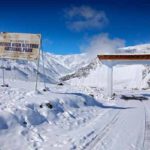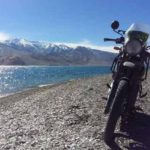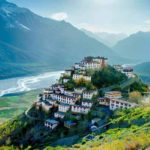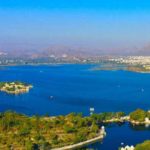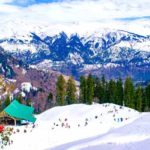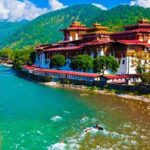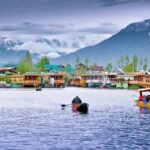Top 10 Places to Visit in Leh Ladakh In the world, there are very few places as lovely as Ladakh and its capital, Leh. Travelers from around the world have been drawn by its mountainous scenery, deep blue lakes and scenic road trips. There are plenty of attractions to take in from magnificent monasteries and elegant palaces to charming villages and high mountain passes, alluring elegance aside. Would you like to know which of these great destinations should be on your bucket list? Check out our cherry picked list of Ladakh’s top 10 places to visit.
Leh, in Jammu and Kashmir, is the main city in the Ladakh region, one of the coldest deserts in the world, a surreal landscape surrounded by the sky-piercing peaks of the snow-capped Himalayan, Zanskar and Karakoram ranges, and adorned with the sparkling waters of the Shyok, Zanskar and Indus rivers. The city of Leh, situated at an altitude of over 11,000 ft above sea level, is a sanctuary for adventure sports. For sports such as trekking, river rafting, hiking, mountain climbing and biking, its rugged terrain and gushing rivers give ripe opportunities. The town is enveloped in a blanket of snow as the winter months approach, making it a heavenly setting for winter sports. The popular Chadar Trek begins 66 km from the village of Chilling, and mostly covers the frozen region of the Zanskar River. Trekkers walk on unstable ice formations during the adventure, linger in caves packed with stalactites and stalagmites, and experience other snowy landscapes.
Three majestic high-altitude lakes, Tso Moriri, Tso Kar, and Pangong Tso, which look like sapphires embedded in the soil, surround Leh. The Magnetic Hill on the outskirts of the city is a natural marvel that leaves visitors in awe. As it continues to drag vehicles upwards, it is said to defy gravity. Leh is a prominent centre of Buddhism and is dotted with many significant monasteries. Tourists will set out on a monastery trail and see the region’s ancient cultures come alive in various paintings adorning the walls while indulging in meditation and other spiritual and therapeutic activities.
Leh was the former capital of Ladakh’s kingdom and boasts a legacy that reflects its rich past. The city enjoys a smattering of heritage sites that remain tall to this day with the 17th-century Leh Palace at its heart, which is a great example of mediaeval Tibetan architecture. Checking into a homestay where the host would leave no stone unturned in immersing guests in Ladakhi culture is one of the best ways to experience the culture of Leh. Another great way to “taste” the area is through its fresh produce: apricots, apples, and other fruits and vegetables found in its orchards and markets.
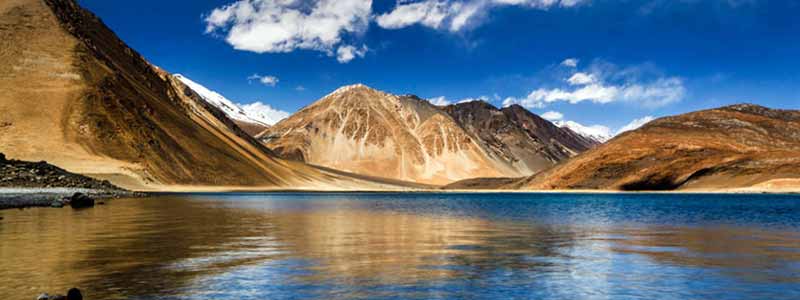
Pangong Tso Lake – An Awesome Camping Site
You never know what surprise nature has in store for you at Pangong Lake in Ladakh. Pangong Lake is the highest saltwater lake in the country, located at an altitude of almost 4,350 m. The water, which seems to be painted blue, stands in stark contrast to the surrounding arid mountains. One-third of Pangong Lake, stretching to almost 160 km, lies in India and the other two-thirds in China.
Pangong Lake, one of Leh Ladakh’s most prominent lakes, derives its name from the Tibetan word “Pangong Tso,” meaning high grassland lake.” You could spend hours here in reflection, and you don’t have enough of its beauty yet. It is also known that Pangong Lake switches colours, appearing at various times in blue, green and red. If you have planned to make a trip to Ladakh in the near future, don’t forget to visit Lake Pangong. It is difficult to explain in words the beauty that awaits you there. Inside yourself, it has to be seen, felt and consumed.
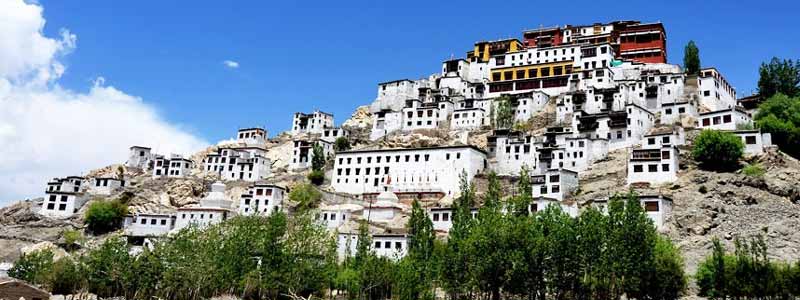
Thiksey Monastery – A Beautiful Monastery
Thiksey Monastery is a monument from the 15th century that belongs to the Tibetan Buddhist Gelug sect. In Lhasa, Tibet, it looks very similar to the Potala Palace and is situated in the Indus Valley at an altitude of 11,800 feet. The village of Thiksey lies just 19 kilometres from Leh. The 12-storey complex is the largest gompa in central Ladakh, home to many ancient paintings, sculptures, and swords on Tibetan walls.
It was founded during the campaign to spread Buddhism in remote areas of Tibet by Je Tsong Khapa, the founder of the Gelug School. He asked his disciples, Jangsem Sherab Zangpo, to use a drop of Tsong Khapa’s blood and bone powder to make a statue of Amitayus, meaning heavenly Buddha, and present it to the king, who at the time resided in the Nubra Valley. The Ladakh King loved the gesture and joined Tsong Khapa and his followers in their campaign.
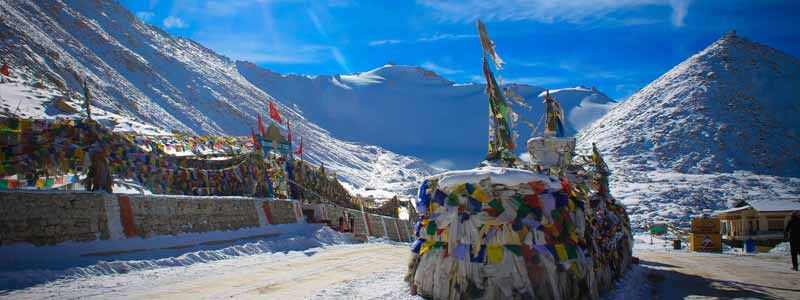
Khardung-la Pass – Gateway To Valleys
Khardung La Pass, or Lower Castle Pass, is the highest motor pass in the world and the gateway to Ladakh’s Shyok and Nubra Valley. Khardung la Pass, one of the most picturesque places in Leh, is located 39 km north of Leh by road and is 18,380 ft above sea level. The road from Leh to Khardung La is asphalted until the South Pullu check post for about 24 km, but from there the road consists of gravel (Loose Rock) and dirt track until the North Pullu check point (15 km and snow melt rivulets. Khardung la pass connects the valleys of Leh and Nubra and also acts as a gateway to the famous glacier of Siachen.
Khardung La pass provides stunning views of the valley and the mountain-winding paths. Khardung La has become a renowned tourist attraction because of the clean weather, scenic views and the feeling of being on top of the world. The visit to Khardung La top includes an internal line permit for Indians and a protected area permit for foreigners. A steady climb over a winding road provided a panoramic view of the town of Leh below and the Stok Kangri peak in the distance. As one climbs up, an isolated gompa on a little hill given an enchanting image. The weather is extremely unpredictable and can change incredibly rapidly, leaving you stranded for hours or even days, so when preparing to visit Khardung La, you need to be prepared. The feeling is no less than winning the universe once you are there.
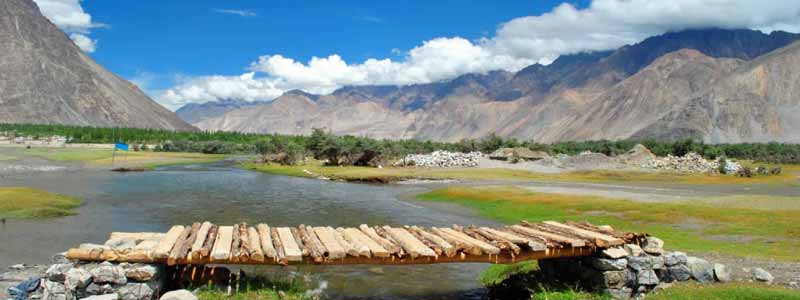
Nubra Valley – Get Arabian Nights Experience
One of the most popular tourist destinations in Ladakh is the Nubra Valley. The site is situated on the Ladakh district’s north-eastern side. Its headquarters are in Diskit Village. The Nubra Valley is situated 120 kilometres away from Ladakh. The valley is the point where two rivers, the Shyok (Indus Tributary) and the Nubra (also known as the Siachen River), converge. The valley separates the Karakoram Mountain Ranges from the Ladakh Range.
The valley, located in the lap of the Himalayas, provides visitors with breathtaking visual beauty. There are numerous tourist attractions in the Nubra Valley. The village of Diskit, which is the region’s headquarters, has a monastery that is the oldest and largest in the region. In the Diskit Monastery, there is a Maitreya Buddha statue which is 106 feet in height. As it has a camel safari showcasing the famed Double Hump Bactrian Camel, Hundar is also a popular destination for tourists.The panoramic area has many hot water springs in the valley and is a popular tourist attraction. At the entrance to the village lies the holy Yarab Tso Pool.
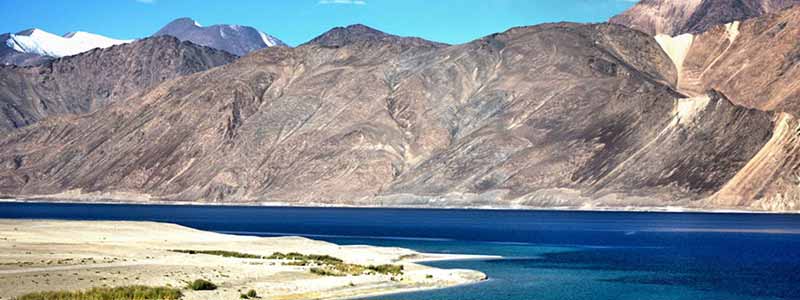
Tso Moriri Lake – A Twin Natural Paradise
Tso Moriri Lake is a brackish lake fed from the mountains by springs and snow-melt. It is located on the Changthang plateau of the Union Territory of Ladakh, at an altitude of 4,530m. Also known as Lake Moriri or Mountain Lake, the lake is the largest high-altitude lake entirely within India’s boundaries. At its height, it is 26 kilometres long and 5 kilometres wide. The lake is part of the Ramsar Wetland Sites and is also recognised as the Tso Moriri Wetland Protection Reserve.
Geographically, Tso Moriri is situated in one of India’s most remote areas, inhabited by Ladakh’s Changpa nomads. The rugged terrain and dirt roads do not make a very comfortable ride for tourists. Depending on your driving skills, you can drive at an average speed of just 40 km/h or even less.
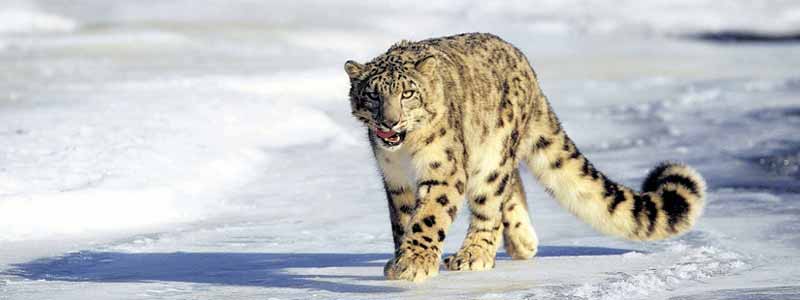
Hemis National Park – Where Endangered Species Live
Some of the most exotic and rare species of flora and fauna are endemic to Hemis National Park. It was established in 1981 and is named after the Monastery of the Hemis, founded by Lama Tagstang in 1630. The sanctuary’s most sought after animal species are Snow Leopards, Shapu, Wild Sheeps, Ibex and Goats. Its natural habitat is home to over 17 species of mammals and 70 birds. Its range of flora, including Anemone, Veronica, Delphinum, Gentiana, Lloydia and Kobresia, is mainly alpine vegetation. Great Grey Shrike, Red Mantled Rose Finch, Black Throated Thrush, Robin Acceptor, Spotted Flycatcher, Himalayan Whistling Thrush, White Rumped Shama, etc. An abode of birds Ladakh Urial, Tibetan Argali, Bharal, Tibetan Wild Ass, Dholes and so on are some of the most endangered animal species that live here. Jeep safaris are the perfect way to see this place and the best time to visit is from May to October.
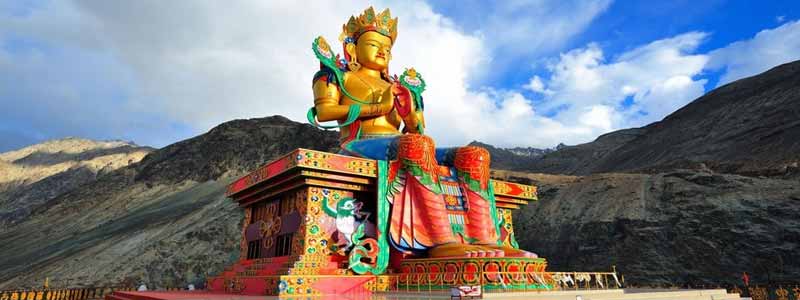
Diskit Monastery – A Famous Attraction
Diskit is the administrative centre of the valley of Nubra and is renowned for its ancient monasteries. This monastery, which dates back to the 14th century, is considered the largest and oldest monastery in the Nubra Valley. Also known as Diskit Gompa, the most prominent attraction of the monastery is the massive statue of Maitreya Buddha atop it, inaugurated by H H H Dalai Lama. One can get a beautiful panoramic view of the Nubra valley from the base of the statue. The monastery was founded in the 14th century by Changzen Tserab Zangpo and is situated on a hill above the plains of the River Shayok. For its extensive array of murals and display of frescoes, one should also visit the monastery. In December, in particular, he visited the monastery to attend the Dosmoche festival held here.
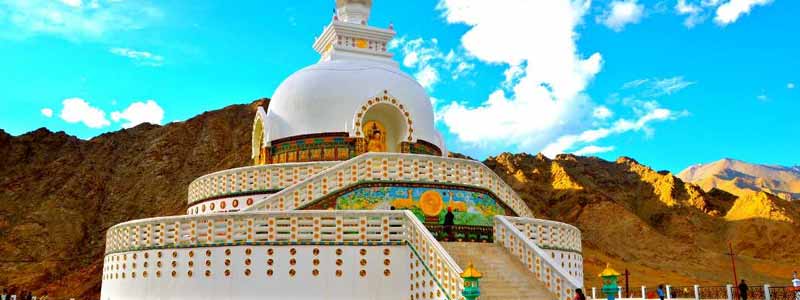
Shanti Stupa – Find Some Peace
Shanti Stupa is located at an altitude of 4267 metres overlooking Leh City, offering a panoramic view of the snow-capped mountains surrounding it. Located at a distance of about 5 km drive from the city of Leh or by climbing 500 stairs, one can reach here. Shanti Stupa’s position is such that it is visible from all over Leh city.
It is constructed as a two-level structure, A flight of stairs leads to the first level where a Dharmchakra (as in the white strip of the Indian national flag) with two deer on each side features a central image of Lord Buddha sitting on a platform turning the Dharmchakra wheel, the second level depicting Buddha’s birth, defeating devils in meditation and Buddha’s death, along with several small images of Buddha meditating, a second level depicting Buddha’s birth, defeating devils in meditation and Buddha’s death,
A white dome Stupa (Chorten) constructed on a Changspa, a steep hill, opposite the Leh Palace, different in Ladhakhi style architecture, gives a spectacular view at sunrise and sunset, illuminated in the white light, it looks more stunning at night. It was designed by the Ladakh and Japanese Buddhists, voluntary work was offered by Ladakhis, construction began in 1983, and His Holiness the Dalai Lama inaugurated it in August 1991. It was constructed to foster peace and prosperity in the world and to commemorate the 2500 years of Buddhism.
In Chanspa, Leh district, Ladakh, in the northern Indian state of Jammu and Kashmir, Shanti Stupa is situated on a hilltop. Shanti Stupa is known as the White-domed Buddhist stupa. The Japanese Buddhist Bhikshu Gyomyo Nakamura designed it in 1991. At its foundation, the Shanti Stupa houses Buddha’s relics, enshrined by the 14th Dalai Lama himself. The Shanti stupa gives a stunning and panoramic view of the surrounding countryside. This has become a primary factor, apart from its religious significance, for Shanti Stupa to become a popular tourist attraction.
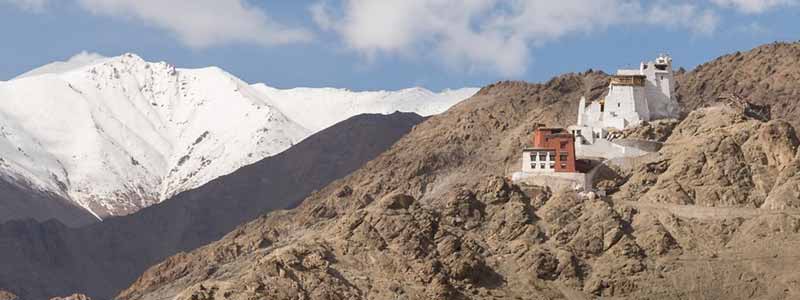
Namgyal Tsemo Gompa – Explore Distinct Mystique
In the 15th century, 1430AD, Namgyal Tsemo Monastery was founded. It was built by King Tashi Namgyal and that is why the monastery was called Namgyal Tsemo Gompa. The Buddhist devotee was King Tashi Namgyal. Situated on the top of the hill, it is famous for its three-storey high solid gold idol of Maitrieya Buddha. Due to the flow of the Indus river, views of the surrounding area, cold blowing air and the snowcapped peaks of the Zanskar range, the climate around namgyal tsemo gompa leh seems very attractive. It contains a rich collection of ancient manuscripts and wall paintings. Gompa contains an assembly hall with some sculptures of Buddhas, temples with frescoes, paintings on the infrastructure of the Namgyal Tsemo monastery.
Situated on the top of the hill, it is famous for its three-storey high solid gold idol of Maitrieya Buddha. Due to the flow of the Indus river, views of the surrounding area, cold blowing air and the snowcapped peaks of the Zanskar range, the climate around namgyal tsemo gompa leh seems very attractive. It contains a rich collection of ancient manuscripts and wall paintings. Gompa contains an assembly hall with some sculptures of Buddhas, temples with frescoes, paintings on the infrastructure of the Namgyal Tsemo monastery.
Namgyal monastery is also famous for its one-storey high statues of Manjushri.and Avalokitesvara. One of the gompas known as Shankar gompa is located along the hilly areas that is affiliated with the monastery of Namgyal tsemo. Namgyal Tsemo palace, which is nine storeys high, is one of the most attraction palaces. For the magnificent and surrounding view that can be seen from the Namgyal Tsemo palace, one can really imagine. As there is no heavy snowfall at this time, the best time to visit the Namgyal Monastery is between June and September. Except these months, it is very difficult for tourists to come and visit the monasteries.
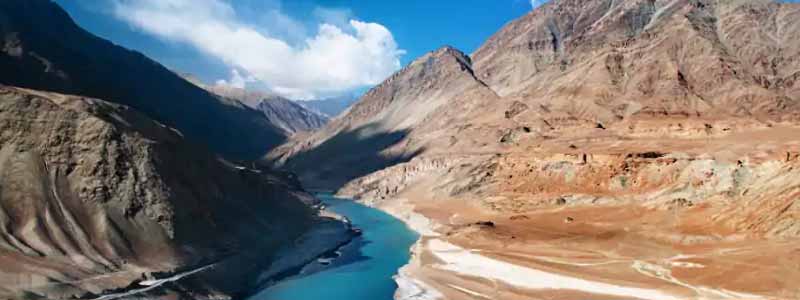
Zanskar Valley – The Desolate Himalayan Place
The Zanskar Valley is a semi-arid region situated at an altitude of 13,154 ft, nestled on the northern flank of the Great Himalayas. The stunning snow-capped mountains here the beautiful weather, the sparkling body of water in Zanskar and the lush landscape draw tourists to this location. The valley is 105 km from Leh and is a hotspot for adventure sports such as hiking, paragliding, water rafting, and more. You can also choose popular trekking options here such as Lamayuru to Darcha, Lamayuru, Padum trek, etc. Tourists are crowded with centuries-old monasteries like Zongla, Zongkhul, Strongdey and one can even camp at the scenic Penzila pass that separates Zanskar from the Suru valley. The temperature will drop to a ferocious -30 degrees Celsius during the winter. Only between the months of June and September can one travel to Zanskar, otherwise all the roads to the valley are heavily covered in snow, thus blocking entry.

